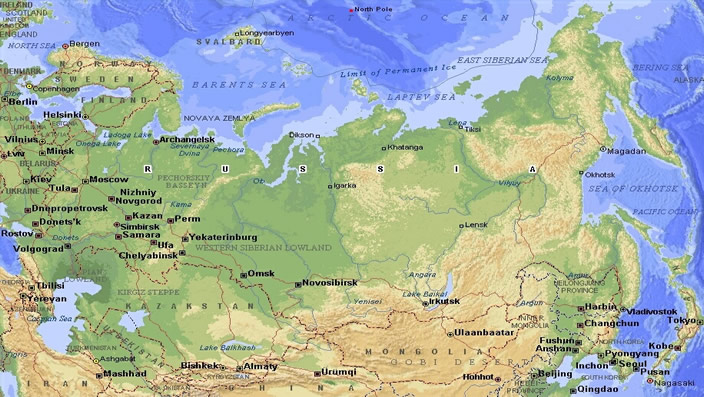
RUSSIA
Russia is the largest country in the world, located in Eastern Europe and north part of Asia.

Population
According to the data provided by the Federal Service of the State Statistics of the Russian Federation, the population of Russia as of September 1, 2009 was 141.9 million people. The majority of the population is concentrated in the European part of the country. 73.3% of the population lives in urban areas, 26.7% - in rural areas. Russia is a multiethnic state. Over 180 nationalities live in Russia, the largest (80% of the population) being Russians. Russian is the official state language. Orthodox Christianity is the dominant religion. Islamic, Catholic, Buddhist and other confessions exist.
State
Russia is a democratic federal state with a republic type of government. The legislative body of the Russian Federation is the two-chamber Federal Assembly (Council of the Federation and the State Duma). The Council of the Federation consists of representatives of each federal entity. The Deputies of the State Duma are elected from party lists on the basis of the proportion of the nationwide votes that each party gets for a term of 5 years.
The Head of State is the President of the Russian Federation, also being the Supreme Commander-in-Chief of the Armed Forces. Citizens of Russia elect the President for a term of 6 years by direct secret ballot vote.
The executive branch is represented by the Government of the Russian Federation. The Chairman of the Government is appointed by the President with the consent of the State Duma. The Russian Federation consists of 83 federal entities (republics, territories and regions), including cities of Moscow and St.Petersburg. Moscow is the capital of Russia.
Territory and climate
The total area of Russia is 6,592,848 sq. miles (17,075,400 sq. km). Over 45% of the country’s area is covered by forests, 4% - by water, 13% - arable land, 19% - deer grazing land, 19% - other.
A large part of the European territory of the country is situated on the East European plain; in the south it is limited by the northern slopes of the Caucasus Mountains and has the Khibin Mountains to the Northwest. To the East of the Ural mountains lies the West Siberian plain surrounded by the mountains of South Siberia (Altay, Sayanas, Baikal mountains, etc.). Between the Yenisey and Lena rivers lies the Midsiberian plateau and further East, between the Lena and the Pacific coast spread the mountains and plateaus of North-East Asia.
Russia has about 2.5 million rivers and 2 million fresh and salt water lakes. The largest rivers are Volga, North Dvina, Don, Pechora, Ob, Yrtysh, Yenisey, Angara, Lena, Amur; the largest lakes are the Caspian (Sea), Baikal, Ladoga, Onega. Russia has 35 national parks and 84 natural reserves.
The climate changes from marine in the extreme Northwest to harsh continental in Siberia and monsoon in the Far East. Russia has the following climatic zones: arctic desert, tundra, forest tundra, forest, forest steppe, steppe, semidesert. Average temperatures in January are from 32 F to -58 F (0° C to -50° C), in July – from 33.8 F to 77 F (+1° to +25° C); precipitation is from 5.9” to 78.8” (150 to 2000 mm) per year. Parts of Siberia and Far East are covered by permafrost.
Land borders exist with the following countries: Abkhazia 152 miles, Azerbaijan 203 miles, Belarus 770 miles, China 2615 miles, Estonia 202 miles, Finland 790 miles, Georgia 346 miles, Kazakhstan 4668 miles, Latvia 168 miles, Lithuania 165 miles, Mongolia 2165 miles, North Korea 10,5 miles, Norway 122 miles, Poland 127 miles, South Ossetia 46 miles, Ukraine 1197 miles.
The country has 12 economic zones (based on regional economic specialization): Northern, Northwestern, Central, Central-Black Earth, North Caucasus, Volga-Vyatka, Volga, Urals, East Siberia, West Siberia, Far East, Kaliningrad.










